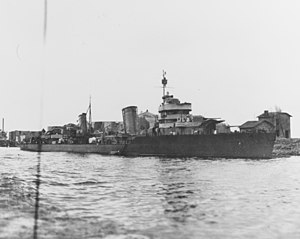
Back ناوشکن لیدر باکو Persian Baku (cacciatorpediniere) Italian Баку (лидер эскадренных миноносцев) Russian Баку (лідер ескадрених міноносців) Ukrainian
 Unknown Leningrad-class destroyer in Leningrad, June 1944
| |
| History | |
|---|---|
| Name | Baku |
| Namesake | Baku |
| Ordered | 2nd Five-Year Plan |
| Builder | Shipyard No. 199, Komsomolsk-on-Amur |
| Yard number | 267 |
| Laid down | 10 March 1936 as Kiev |
| Launched | 25 July 1938 |
| Decommissioned | 18 April 1958 |
| In service | 27 December 1939 |
| Renamed |
|
| Reclassified |
|
| Stricken | 30 July 1963 |
| Honours and awards | Order of the Red Banner, 6 March 1945 |
| Fate | Scrapped, 1964 |
| General characteristics (as built) | |
| Class and type | Leningrad-class destroyer leader |
| Displacement | |
| Length | 127.5 m (418 ft 4 in) (o/a) |
| Beam | 11.7 m (38 ft 5 in) |
| Draft | 4.06 m (13 ft 4 in) |
| Installed power |
|
| Propulsion | 3 shafts; 3 geared steam turbines |
| Speed | 40 knots (74 km/h; 46 mph) |
| Range | 2,100 nmi (3,900 km; 2,400 mi) at 20 knots (37 km/h; 23 mph) |
| Complement | 250 (311 wartime) |
| Sensors and processing systems | Arktur hydrophones |
| Armament |
|
Baku (Russian: Баку) was one of six Leningrad-class destroyer leaders built for the Soviet Navy during the 1930s, one of the three Project 38 variants. Completed in late 1939, the ship was assigned to the Pacific Fleet. About a year after the German invasion of Russia in June 1941, she was ordered to join the Northern Fleet, sailing through the Arctic Ocean. Together with several other destroyers, Baku left the Soviet Far East in July 1942 and arrived off Murmansk three months later where she began escorting convoys, mostly in the White and Barents Seas. The ship was badly damaged in a storm that sank another Soviet destroyer in November and was under repair for several months. Baku spent most of the rest of the war on convoy escort duties, although she did bombard several German-occupied towns during the Petsamo–Kirkenes Offensive of October 1944. The ship and her crew were awarded the Order of the Red Banner in early 1945 for their performance during the war.
After the war, she was refitted and rejoined the Northern Fleet in 1946. For the next several years she exercised during the warm months and was put in reserve during winter. The following year she starred in a movie about a fictional destroyer during the war. Baku began a lengthy overhaul in 1948 that lasted until 1954. Upon its completion she was used for experimental work and was formally reclassified as an experimental ship two years later. Baku was converted into a target ship in 1958, but was hulked as a depot ship a few weeks later. She became an accommodation ship in 1959 and was finally struck from the Navy List in 1963 and scrapped the following year.
© MMXXIII Rich X Search. We shall prevail. All rights reserved. Rich X Search